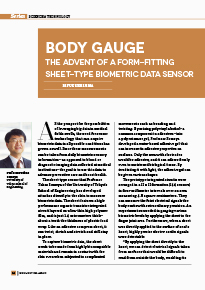Home > Highlighting JAPAN >Highlighting Japan April 2015>Science & Technology
Highlighting JAPAN

Science & Technology
Body Gauge
The advent of a form-fitting sheet-type biometric data sensor

AS the prospect for the possibilities of leveraging big data in medical fields swells, the need for sensor technology that can acquire biometric data in all possible conditions has grown as well. Since these measurements can be taken from daily biometric sensory information—as opposed to blood or diagnostic imaging data collected at medical institutions—the goal is to use this data to advance preventive care and boost health.
The sheet-type sensor that Professor Takao Someya of the University of Tokyo’s School of Engineering has developed attaches directly to the skin to measure biometric data. The sheet features a high-performance organic transistor integrated circuit layered on ultra-thin high polymer film, and is just 1.4 micrometers thick—about a tenth the thickness of plastic food wrap. Like an adhesive compress sheet, it can twist, shrink and stretch and still stay in place.
To capture biometric data, the sheet needs to be made from highly biocompatible materials and remain in contact with the skin even when subjected to complicated movements such as bending and twisting. By mixing polyvinyl alcohol—a common component in adhesives—into a polyrotaxane gel, Professor Someya developed a water-based adhesive gel that can increase its adhesive properties on surfaces. Only the area with electrodes would be adhesive, and it can adhere firmly even to moistened biological tissue. By irradiating it with light, the adhesive gel can be given various shapes.
The prototype integrated circuits were arranged in a 12 x 12 formation (144 sensors) in four-millimeter intervals over an area measuring 4.8 square centimeters. They can measure the faint electrical signals the body emits with extraordinary precision. An experiment succeeded in gauging various biometric levels by applying the sheet to the finger joint area. Furthermore, when a sheet was directly applied to the surface of a rat’s heart, highly precise electro-cardio signals were detectable.
“By applying the sheet directly to the heart, we can detect electrical signals taken from surfaces that would be difficult to read from outside the body, enabling its use in diagnostics that can potentially be very helpful but different from traditional methods of examination,” Professor Someya says hopefully.
Since adhesive materials eventually lose their stickiness, the sensors can be removed without difficulty from locations such as the skin or surface of the heart after measurements are taken. The sensor sheet’s adhesive qualities and duration of use can be predetermined in accordance with how and where it will be placed. Because it is being applied to organic surfaces, adjusting the stickiness is the key; making it too sticky will make removal difficult, and if it isn’t sticky enough, it won’t adhere properly.
As a specialist in the research of organic transistors, Professor Someya has been renowned for developing the world’s thinnest, lightest and most flexible sensor sheet. In the drive to develop even thinner and more flexible sheets, he eventually devised a sensor that could be directly applied to the body. The problems he faced in development were many and complex. “Electronic devices deteriorate from contact with water and oxygen, so hot and humid conditions are the worst environment,” he explains. “Yet safety is an absolute requirement, and we also had to deal with the difficulty of developing a sensor that could operate reliably without becoming disrupted by complicated movements.”
Professor Someya’s sensor sheet can continuously conduct high-precision sensory operations under conditions so natural that subjects do not even perceive they are being monitored. Since it is clear that this device can be used inside the body in locations such as the heart, its use is anticipated in a variety of fields, including medicine, healthcare, sports and welfare. Advancing to human applications requires confirmation of issues such as safety and biocompatibility, but as the ultimate wearable device, it holds potential for expanding the possibilities of electronic devices.
© 2009 Cabinet Office, Government of Japan






